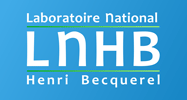ICRM Beta Particle Spectrometry Working Group
The Beta Particle Spectrometry Working Group is devoted to the development of the metrological aspects of beta spectrometry and its applications. This includes, but is not restricted to:
- Theory
- Beta (β±) and electron capture (ε) transitions
- Theoretical shape factors and influence of the nuclear current
- Atomic effects
- Experiments
- Instrumentations used for beta spectrometry
- Techniques that need beta information
- Confidence on experimental shape factors
- Data analysis and unfolding methods
- Simulations
- Confidence on the physical processes: low energies, radioactive decays, atomic rearrangements
- Comparison of the results of different codes: Geant4, Penelope, etc.
- Evaluations and dissemination
- Confidence and uncertainties on experimental shape factors
- Evaluation procedure for establishing recommended experimental shape factors
- Mean energies, log ft values, database
Interested communities in radionuclide metrology are: nuclear decay data, liquid scintillation counting, ionizing chambers, 4π β-γ counting.
Any experimental shape factor found in the literature can be sent to the coordinator who will keep up-to-date a dedicated database.
Any other suggested topic is welcome. If you want to participate to this working group, please E-mail your contribution to the coordinator: xavier.mougeot@cea.fr
Projects
EMPIR Project PrimA-LTD “Towards new primary activity standardisation methods based on low-temperature detectors” (2021 – 2024)
Radionuclide metrology and specifically activity standardisation are based on well-established measurement techniques, which have been used and improved for decades. However depending on the decay mode, for some nuclides, the achievable uncertainty on the activity is up to an order of magnitude larger than usual. The aim of this project is to achieve new primary activity standardisation methods based on low-temperature detectors, in particular by measuring with high statistics the 55Fe and 129I decays. A high-precision theoretical description of these two decays, including both nuclear and atomic structure, will also be conducted.
Coordinator: Ole Nähle (ole.j.naehle@ptb.de)
Website: https://prima-ltd.net/
EMPIR Project MetroMMC “Measurement of fundamental nuclear decay data using metallic magnetic calorimeters” (2018 – 2021)
The main objective of the MetroMMC project is to improve the knowledge of electron capture decay and subsequent atomic relaxation processes. New theoretical calculation techniques and extensive experiments using MMCs will be developed to determine important decay data which are relevant for primary activity standardisations in radionuclide metrology, in cancer therapy on the DNA level, and when studying the early history of the solar system. The experimental parts will be complemented with a new approach based on microwave coupled resonators.
Coordinator: Dirk Arnold (dirk.arnold@ptb.de)
Website: http://empir.npl.co.uk/metrommc/
EMPIR Project MetroBeta “Radionuclide beta spectra metrology” (2016 – 2019)
This project proposes both theoretical and experimental approaches to improve the knowledge of beta spectra. On the theoretical side, the existing knowledge of the calculation of nuclear wave functions will be used to account for the nuclear structure effect on these spectra. On the experimental side, the development of beta spectrometry with metallic magnetic calorimeters, a class of cryogenic detectors operating at very low temperature, and solid scintillators containing the beta emitters in the structure of the scintillator crystal are addressed. These detectors have the potential to measure the shapes of beta spectra with unprecedented precision and, in particular in the case of metallic magnetic calorimeters, low systematic errors. Comparison of the newly calculated and measured spectra, as well as the application of several complementary detection techniques, will validate the quality of the spectra.
Coordinator: Mark A. Kellett (mark.kellett@cea.fr)
Website: http://metrobeta-empir.eu/
Meetings
MetroMRT Workshop – Paris, France, 21st-22nd May 2014. Website: http://projects.npl.co.uk/metromrt/
ICRM 2015, 20th International Conference on Radionuclide Metrology and its Applications – Vienna, Austria, 8th-11th June 2015. First meeting of the Beta Particle Spectrometry Working Group.
Kick-off meeting of MetroBeta – Saclay, France, 5th-6th July 2016.
6th Decay Data Evaluation Project Workshop and ICRM Working Group meetings – National Physical Laboratory, Teddington, UK, 19th – 22th September 2016.
Software
BetaShape
The BetaShape program has been developed for improving the nuclear data related to beta emission properties. The theoretical model was implemented with analytical calculations, except for the relativistic electron wave functions which are numerical solutions of the Dirac radial equations. Mean energies, log ft values as well as beta and neutrino spectra for single and multiple transitions are provided. A database of experimental shape factors is also included and the uncertainties from the input parameters are propagated.
Link: http://www.lnhb.fr/rd-activities/spectrum-processing-software/
Working Group reports
Annual reports of the Working Group are available here:
- 2023: ICRM_BetaWG_Report_2023.pdf
- 2020: ICRM_BetaWG_Report_2020.pdf and ICRM_BetaWG_ExtendedReport_2020.pdf
- 2019: ICRM_BetaWG_Report_2019.pdf
- 2018: ICRM_BetaWG_Report_2018.pdf
- 2017: ICRM_BetaWG_Report_2017.pdf
- 2016: ICRM_BetaWG_Report_2016.pdf and associated presentation.
- 2015: ICRM_BetaWG_Report_2015.pdf
- 2014: ICRM_BetaWG_Report_2014.pdf
Scientific publications
Relevant articles, books and reports for beta spectrometry and its applications will be listed here after agreement of the members of the Working Group.
Disclaimer
This site is non-commercial. Materials and manufacturers are cited only for information purposes and citation does not mean that the site host or the working group recommend or support these materials. Any hyperlinks are only given for convenience and do not imply any support from the working group, the International Committee for Radionuclide Metrology or the French Commissariat à l’Énergie Atomique et aux Énergies Alternatives.
The opinions presented in this site are those of the ICRM working group moderated by the coordinator.
